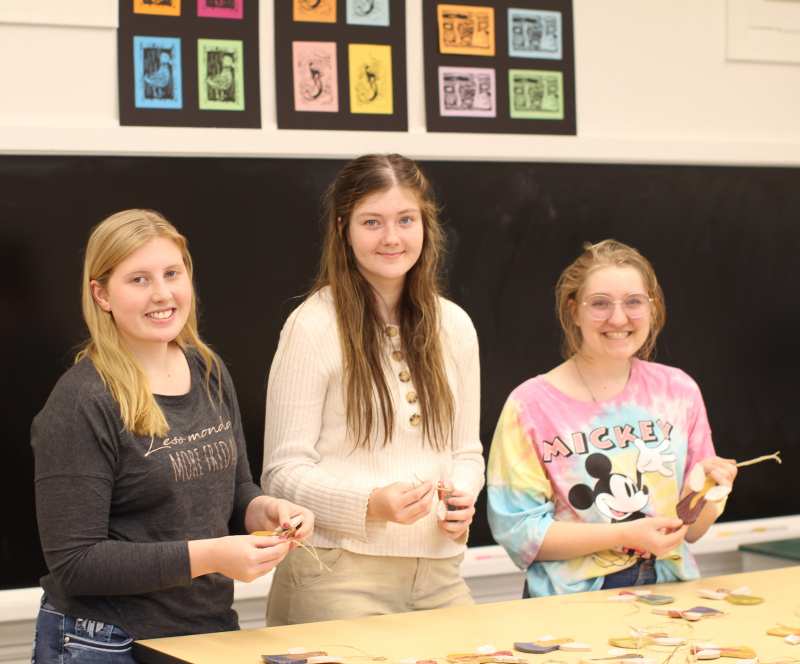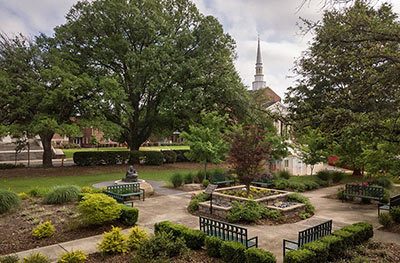Christmas Ornament, Print Sale Helps Send MC’s Art Education Students to National Conference

Christmas trees throughout the Southeast will soon be adorned with multicolored angels, crosses, doves, state silhouettes – and even Mississippi College’s popular new brand mark – thanks to the breathtaking work of MC students-artists.
Members of the Clinton community can deck their halls with original pieces and support MC senior art students on their way to the National Art Education Association Convention by purchasing handmade Christmas ornaments and prints this holiday season.
Dr. Stephanie Busbea, art education coordinator and professor in the Department of Art at MC, said the annual sale has evolved during the last 15 years.
“We were learning for a lot of years, but we have developed a system that works,” said Busbea, recipient of the 2022 NAEA Preservice Chapter Sponsor Award of Excellence. “We try to have the upperclass students, who have done this many times, partner with the underclass students, so their time is spent making ornaments and prints and getting to know the new students.
“The pressures of studying can get uncomfortable during the first year of college, and we try to make this a fun activity for our students.”
For art education majors like Dani Henderson, a senior from Waynesboro, and Cate Stennett, a junior from Melissa, Texas, the annual sale presents an opportunity to express their creativity and learn how to market their work while building relationships that will last a lifetime.
“This is something all art education majors get together and do as our group fund-raiser,” Henderson said. “We meet up and do this on different nights of the week. It’s a great way to get to know one another.
“We build relationships, which is important in the education community, but we’re also learning something we can do with our future students.”
The department’s friendly, “down-home” environment was new to Sennett, who grew up in a military family and moved around the country for most of her life.
“This art community has been one of the first places that has felt like my home,” Sennett said. “Getting to work on these pieces together has made me feel like I have a place where I belong.”
From start to finish, the student artists go through a painstaking process to ensure the ornaments and prints they sell achieve a professional appearance.
The ornaments begin as a slab of clay that the student artists cut into templates and bisque fire in a kiln. After removing them from the thermal chamber and allowing them to cool, the student artists glaze each ornament by hand before returning them to the kiln to be fired again, which gives the ornaments a nice, glossy finish. The student-artists cut pieces of twine, fashion them into nifty loops, and thread them through the finished pieces.
“I had never touched clay before I came to MC,” Stennett said. “I had no clue how to do this, but you learn by doing, and by the second or third year, you’ve become a pro at it.”
The relief prints for sale range from donuts, lemons, and oranges to ducks, koi fish, and swans. Student artists carve designs into blocks of linoleum to make plates. They use a set of rollers – called a brayer – to apply ink to the surface of the block, then press the block onto high-grade paper to make a single print.
Several prints on different-colored paper may be cut into segments and glued together to make unique collages. All prints and collages are precut, pre-matted, signed by the artist, and ready to be placed in a frame.
“This is something we can do in our schools if we have linoleum available to us,” said Henderson, who aspires to become an art educator. “Even if we don’t, you can do similar-style printing using foam or similar materials.
“It’s another art form that we’re learning. I’ve never had printing before, so learning how to carve into linoleum is an important process for us, and teaches us some different techniques.”
Stennett said the opportunity to make prints reinforces what she learned in MC’s print-making classes.
“This project was like a quick overview of that class,” Stennett said. “We learn to carve into a bunch of different materials. Two in our group had taken the class, so it was helpful to have the more experienced students work with some of the less experienced on these prints.”
Proceeds from the ornament and print sale are used to pay for senior art education students to attend the NAEA’s conference, a splendid networking opportunity for those about to enter the profession: about 7,000 art teachers from across the country attend the annual event.
“You get to meet different people from different organizations,” said Henderson, who attended the NAEA conference in New York in March. “We also meet some of the art suppliers from around the country and start making connections, so when we’re in our classroom, and we need to bulk-order supplies or call another teacher from a close district, we have those connections.
“We also get to go on different trips to museums. (Participating in the Christmas ornament and print sale) is a great way to support art education and future educators.”
Having the opportunity to view some of the most famous works of art in person could provide added value for the generations of students they will one day teach.
“Until I came to college, I had never been to any art museums,” Henderson said. “When I got to go to the NAEA Conference in New York City, I got to visit the Guggenheim and the Modern Museum of Art and the Met, which was an incredible experience.
“Being able to tell my future students that their teacher has been there and seen the great works of art they’re studying is incredible.”
The ornament and print sale also helps MC student artists discover how to market their work and build a brand that can enhance their status as art instructors.
“It’s a great way to establish ourselves in the community, not only as art educators, but as artists,” Henderson said. “When you’re selling your art, it adds to your credibility as a teacher who can make things that have monetary value as much as aesthetic value.”
Because the courtyard in the Samuel Gore Arts Complex that houses a large kiln has yet to be completed, the student artists crafted the ornaments in the ceramics room in the Aven Fine Arts Building. They glazed the pieces and prepared the prints in the state-of-the-art facility, however, and are looking forward to moving permanently into the complex when it opens fully in the spring.
“Next year, we’re going to have two ceramics rooms – a wheel-throwing room and a hand-building room,” Stennett said. “When we’re working on these projects, we’ll mostly be in the hand-building room while other students can throw on the wheel, which will be nice.”
Individual ornaments cost $10 each for multicolored pieces or the MC brand mark, and $7 each for single-colored pieces; individual prints cost $15.
Ornaments and prints will be available for sale from 11 a.m.-1 p.m. and from 5-7 p.m. Monday-Wednesday, Nov. 28-30, in the Cafeteria in the B.C. Rogers Student Center; from 11 a.m.-1 p.m. and from 5-7 p.m. Thursday, Dec. 1, in the Commons in the basement of Alumni Hall; and from 11 a.m.-1 p.m. Friday, Dec. 2, in the Commons. Ornaments may also be ordered by emailing Laura Wingo, fundraising chair, at ljwingo@mc.edu.
Sign-up For Our Newsletter
Get the latest news about Mississippi College delivered right to your inbox by subscribing to the Along College Street e-newsletter.


